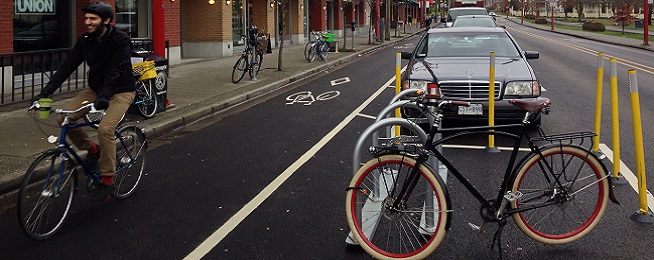PARKing day is a global event designed to help people re-imagine roadways to replace on-street car parking with other activities.
Bicycle Network is joining forces with the Planning Insitute of Tasmania and the University of Tasmania this Friday 21 September to take two car parking bays in Collins Street for the day.
Bicycle Network will be providing bicycle parking for the bay which will be turned into a “parklet”, with seating and plants outside Fullers Bookstore and Bed Bath and Table.
Business owners often worry that removing on-street parking will negatively affect trade. But research and experience from around the world has found that cycleways bring more people into streets, and thus more potential customers for businesses.
Collins Street is one of the routes where we want to see a separated cycleway, connecting the Rivulet Path to the city and beyond to the Intercity Cycleway.
If parking down one side of Collins Street was removed there would be plenty of room to install a bi-directional, separated cycleway.
Collins Street is a prime example of a location where there is off-street parking nearby and at the southern end on-street parking is under utilised.
Most businesses over-estimate the importance of car travel for their customers. One Austrian study found retailers thought about 58% of customers arrived by car but the reality was 32%, with the majority (44%) walking. Similar results have been found in research carried out in Scotland, New Zealand and Melbourne.
Business benefits
In places where car parking or traffic lanes have been removed to make way for separated cycleways, studies of businesses have found that takings didn’t change or improved compared to similar areas.
The City of Toronto put in a separated cycleway on Bloor Street, which was already a popular cycling route. Through business and pedestrian surveys, it found that most businesses reported an increase in the number of customers, most visitors reported spending more and visiting more frequently, and shop vacancy rates were stable.
The New York City Department of Transportation measured quarterly sales before and after in four street improvement projects, most of which included dedicated cycling infrastructure. All the projects saw sales of similar or greater levels as neighbouring areas, with the positive difference more noticeable a few years after the bikeway went in.
A European Commission study in Germany found that people who regularly rode bicyles to shopping areas visited 11 times per month as opposed to people who drove at 7 times. This is reflected in other studies in the US which found riders spend less per visit but shop more frequently.
Bicycle parking
Research in Lygon Street in Carlton found that while bicycle riders spend less than car drivers per hour, $47 versus $65, bicycle parking takes up less space so that bike riders generate $31 per parking space as opposed to car drivers who generate $6. A car park converted to bicycle parking could easily accommodate six bikes, so could lead to greater benefit for businesses.
Some cities trial bike parking in car parking bays and if they are utilised, convert them permanently.
Image: Paul Krueger on Flickr


